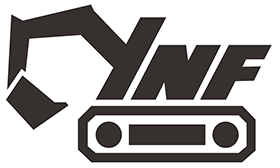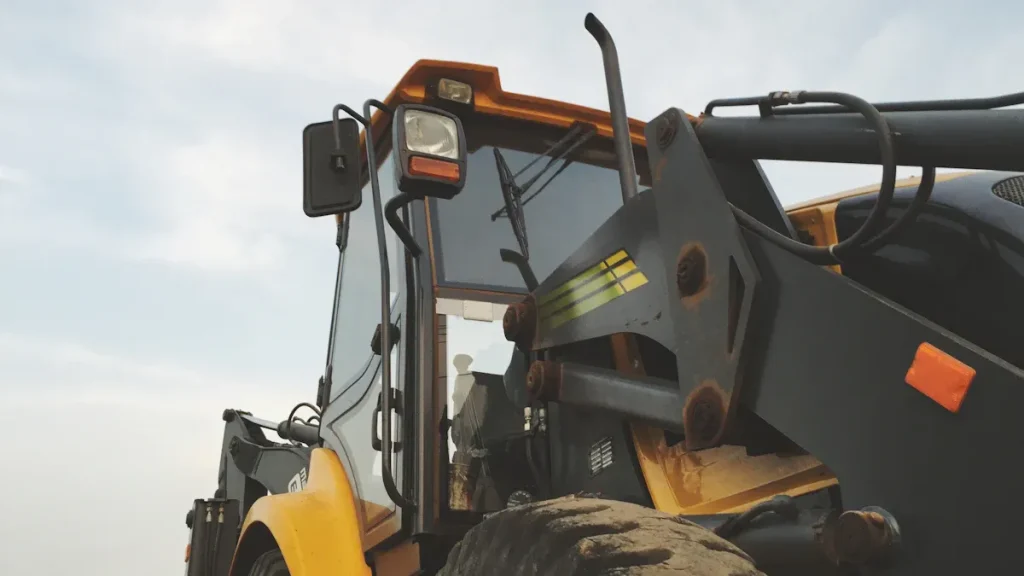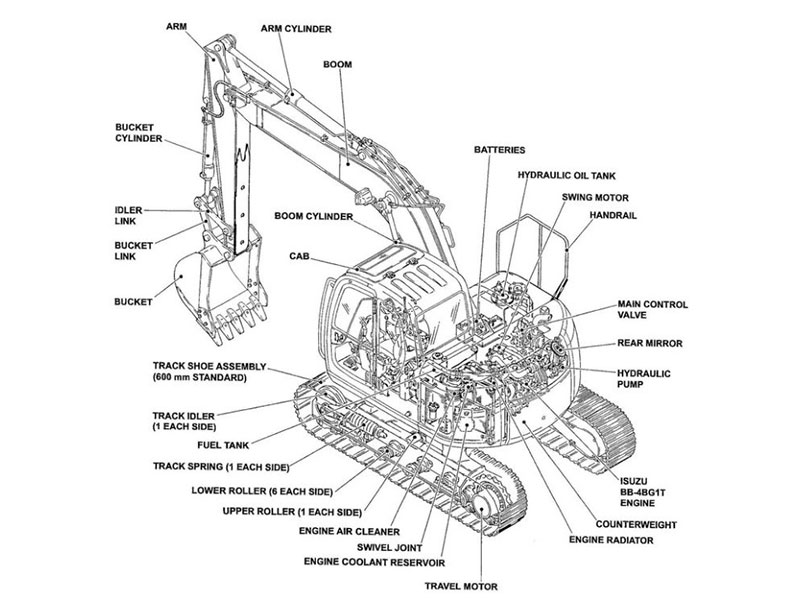
When you look at diagram excavator engine parts, you see a simple map. It shows how each part fits inside an excavator. A diagram tells you where all the parts go. It also shows how they connect to each other. If you want to learn about excavator repairs, these diagrams help a lot. They help you find the right parts fast. You can use a diagram to pick the correct parts for your excavator. With practice, reading diagram excavator engine parts gets easier. You will feel more sure when working with your excavator.
Key Takeaways
Excavator engine parts diagrams are like maps. They show where each part goes. They also show how parts connect. This makes fixing and taking care of the engine easier.
Learning to read diagrams helps you find parts fast. It helps you avoid mistakes. You can see how the engine and hydraulic systems work together.
Use diagrams often to check fluid levels. Diagrams help you spot leaks. They help you do maintenance. This keeps your excavator working well. It stops big problems from happening.
Always match part numbers and labels with care. Wear safety gear every time. Follow instructions to stay safe. This keeps your excavator in good shape.
Practice reading diagrams a lot. Ask experts for help if you need it. Use interactive tools when you are unsure. This helps you feel confident. It makes your repair skills better.
Diagram Excavator Engine Parts
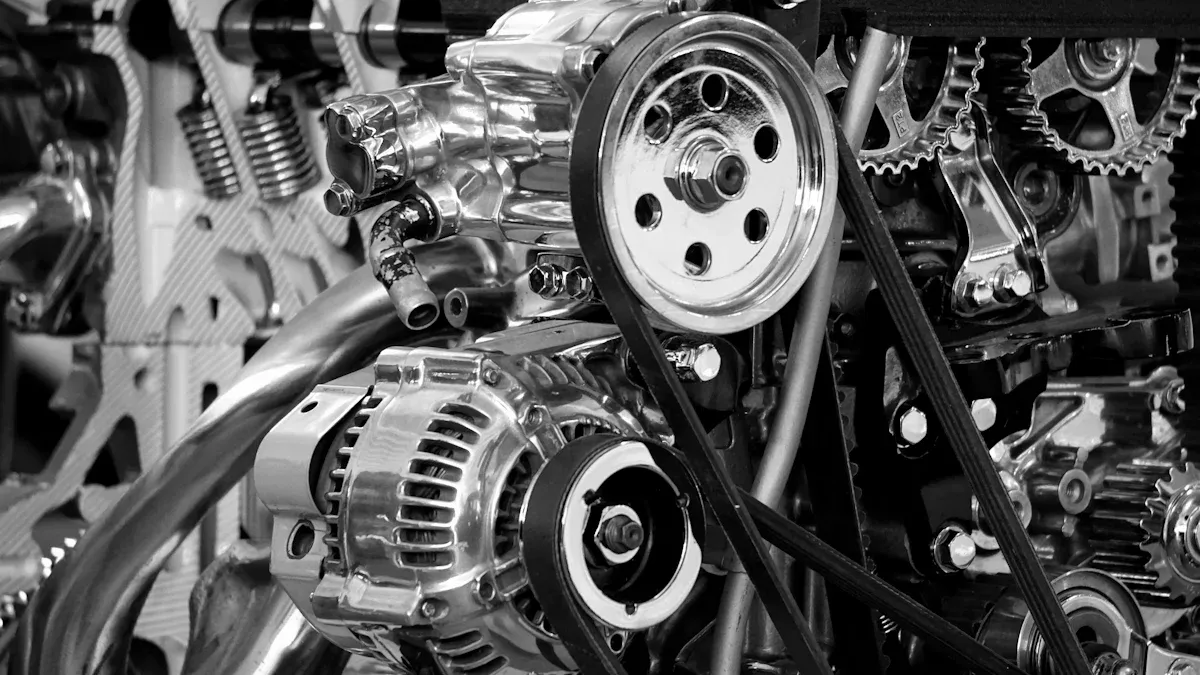
What Is a Parts Diagram
A diagram excavator engine parts chart is like a map. It shows all the main engine parts and accessories. You can see how each part fits inside the excavator. Diagrams show the engine, fuel and air systems, hydraulic pump, control valve, turbocharger, and mechanical linkages. When you look at a diagram, you find the engine and see how it connects to the hydraulic system. These diagrams help you pick, name, and order the right excavator parts for fixing or keeping your machine working. If you want your excavator to work well, you should learn how to read a diagram excavator engine parts chart.
Key elements you find in a typical excavator diagram:
Engine: Turns diesel fuel into movement and powers the excavator.
Fuel and air systems: Make the engine run better.
Main hydraulic pump: Changes engine power into hydraulic energy.
Main control valve: Sends hydraulic fluid and controls pressure.
Turbocharger: Makes the engine stronger by pushing more air in.
Mechanical linkages: Join different engine parts and systems.
How to Read Diagrams
First, look at the diagram and find the labels for each part. Diagrams use lines and shapes to show how engine parts connect. The engine is in the middle, with hydraulic lines going to pumps and valves. Match the numbers or codes on the diagram to the parts list. This helps you order the right excavator parts. Check for connections between the engine and hydraulic system. If you use an interactive diagram, you can click on parts for more details. Always check serial numbers and model specs before you order parts.
Tip: Diagrams often show maintenance needs, fluids, and service limits. These notes help you know when to replace or fix excavator engine parts.
Common Symbols
Excavator diagrams use symbols for hydraulic and engine parts. You see pumps, motors, cylinders, accumulators, and valves. Each symbol tells you what the part does. For example, a pump symbol means it moves hydraulic fluid. A valve symbol shows where you control fluid direction or pressure. You also see symbols for electric motors, filters, coolers, and temperature indicators. Knowing these symbols helps you read any excavator diagram.
Category | Common Symbols and Representations |
|---|---|
Pumps (Hydraulic) | Fixed Displacement Pump, Variable Displacement Pump |
Motors and Cylinders | Hydraulic Motor, Single Acting Cylinder, Double Acting Cylinder, Differential Piston Cylinder |
Valves | Check Valve, Manual Shut-Off |
Miscellaneous Units | Electric Motor, Accumulator, Heater, Cooler, Filter, Pressure Switch, Temperature Indicator |
Methods of Operation | Spring, Pressure Relief, Manual, Flow Control, Push Button, Pedal, Solenoid, Servo Motor |
You use these symbols to find and understand engine parts and hydraulic system connections. This makes fixing and checking your excavator easier.
Excavator Engine Parts Overview
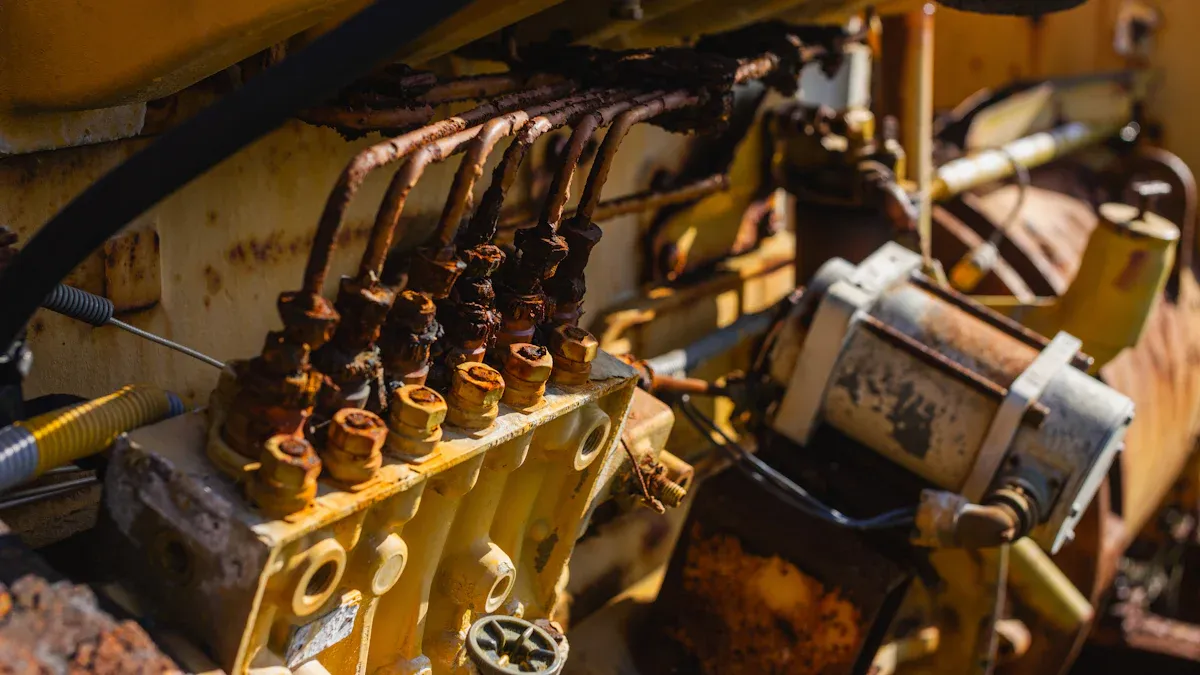
Excavator engine parts work together to make the machine move. Each part has a job to help the excavator run well. You should know what each part does to keep your machine working and stop problems. The diagram shows where each part is and how it links to the hydraulic system, undercarriage, and attachments. Here are the main excavator engine parts you will see in most diagrams.
Engine Block
The engine block is the main part of the excavator engine. It is the biggest part you will see in the diagram. It holds the cylinders, pistons, and crankshaft. Fuel burns inside the cylinders to make power. The engine block keeps all the other parts in place and lined up.
Holds cylinders, pistons, and crankshaft
Gives strength and support
Is where fuel burns for power
Pistons
Pistons move up and down inside the engine block. They change fuel energy into movement. When fuel burns, pistons push down and turn the crankshaft. This makes the hydraulic pump, final drive, and undercarriage work. Pistons help the excavator dig, lift, and move things.
Change fuel energy into movement
Turn the crankshaft and hydraulic pump
Help with digging and lifting
Crankshaft
The crankshaft connects to the pistons. It turns their up-and-down motion into spinning. This spinning moves the tracks and undercarriage. The crankshaft also helps run other engine parts like generators and compressors. A smooth crankshaft helps the excavator work well.
Turns piston movement into spinning
Moves tracks and undercarriage
Runs other engine parts
Camshaft
The camshaft opens and closes the engine valves. It works with the crankshaft to keep the engine running right. The camshaft lets fuel and air into the cylinders at the right time. It also helps push out exhaust gases after burning.
Fuel Injectors
Fuel injectors spray fuel into the cylinders. They make a fine mist so fuel mixes better with air. Good fuel injectors help the engine make more power and use less fuel. You need to keep them clean for the excavator to work well.
Spray fuel for burning
Help make more power and use less fuel
Need to be kept clean
Turbocharger
A turbocharger uses exhaust gases to spin a turbine. The turbine pushes more air into the engine for more power. Turbochargers help the excavator lift heavy things and use less fuel. You can do more work with less fuel.
Tip: Turbochargers help small engines work like big ones, saving space and money.
Cooling System
The cooling system stops the engine from getting too hot. It has a radiator, oil cooler, fan, hoses, and thermostat. These parts move heat away from the engine and hydraulic system. You should check coolant and clean the radiator to stop damage.
Radiator and oil cooler take away heat
Fan moves more air
Hoses and thermostat control coolant
Exhaust System
The exhaust system takes away gases after burning. It uses filters and catalysts to lower pollution. Mufflers and silencers make the engine quieter. A good exhaust system helps the excavator follow rules and keeps it quiet.
Lubrication System
The lubrication system covers moving parts with oil. This lowers friction and heat. Lubrication stops parts from wearing out and keeps the engine running well. You should check oil and change it often.
Lowers friction and heat
Stops wear and damage
Makes the engine last longer
Electrical Parts
Electrical parts help start and control the excavator engine. You will see the starter motor, battery, alternator, ECU, wiring harness, control panels, and sensors. These parts help start the engine, check how it works, and control attachments and undercarriage.
Electrical Part | Function | Importance |
|---|---|---|
Starter Motor | Turns the engine to start it when you turn the key. | Needed to start the engine; if broken, the engine will not start. |
Battery and Alternator | Battery keeps power; alternator charges battery and runs electrical parts. | Keeps power going; if alternator fails, battery dies and problems happen. |
Engine Control Unit (ECU) | Controls engine by using sensor data to make it work better and cleaner. | Helps engine run smooth, saves fuel, and meets rules. |
Wiring Harness | Connects electrical parts and sends power and signals. | Needed for all electrical parts to work together; if worn, it needs fixing. |
Control Panels & Switches | Lets the operator control electrical parts and see how things are working. | Gives real-time info and control, making work safer and easier. |
Sensors | Check engine temperature, pressure, fuel, load, and send info to ECU. | Make the engine safer and better by giving alerts and letting ECU adjust things. |
You need to know these excavator engine parts to keep your excavator, undercarriage, hydraulic system, and attachments working well.
Identify Excavator Parts in Diagrams
Locating Parts
You need to find the right parts in an excavator diagram before you fix or check anything. Start by looking for the biggest parts, like the boom and bucket. These help you know where you are in the diagram. Use the diagram like a map to look for smaller engine and hydraulic parts. Some diagrams let you click on parts or labels to learn what they do and where they are. If you are not sure, you can ask parts experts or customer service for help. Many suppliers, such as YNF Machinery, have online forms or phone numbers to help you find engine parts fast.
You can make this easier by following these steps:
Find the main excavator parts first.
Use the diagram to look closer at engine or hydraulic parts.
Check part numbers with your machine’s manual or lookup tools.
Look at manufacturer guides for symbols you do not know.
Ask experts if you still have questions.
Compare the parts on your excavator to the diagram, looking for special marks.
Study the diagram’s layout, symbols, and legend to get better.
Get tools like flashlights and magnifying glasses to see small details.
Keep learning with workshops and online guides to get better at finding excavator parts.
Tip: Using interactive diagrams and asking experts can help you save time and avoid mistakes when you look for engine and hydraulic parts.
Matching Labels
Labels in an excavator diagram help you match each part to its name and job. Standard labels use colors and numbers. These help you pick the right parts and avoid mistakes. Good tagging follows industry rules, which helps people talk clearly and stay safe. Clear labels help you find engine and hydraulic parts fast, making repairs easier.
Color tags help you spot hydraulic lines and engine parts.
Number systems match diagram parts to the parts list.
Labels show safety warnings, so you do not make risky mistakes.
Good tagging helps keep track of parts and makes records correct.
If you use a diagram with clear labels, you can find the right parts faster. You also lower the chance of making mistakes. Always check that the labels in the diagram match the tags on your excavator.
Note: Matching labels in diagrams and on your excavator helps you avoid mix-ups and keeps your work safe.
Avoiding Mistakes
Mistakes can happen if you read the diagram wrong or mix up engine and hydraulic parts. You can avoid errors by following good steps. Always check part numbers with your manual or trusted lookup tools. If you see symbols you do not know, look at the manufacturer’s guide. If you are still unsure, ask an expert for help.
Get your workspace ready before you start. Use good lights and tools to see small details in the diagram and on your excavator. Compare special marks to make sure you have the right parts. Keep learning about diagram symbols and layouts to get better at finding parts.
Common Mistakes | How to Avoid Them |
|---|---|
Misreading symbols | Study the legend and manufacturer’s guide |
Mixing up part numbers | Check with manual and lookup tools |
Ignoring safety labels | Always look for warnings in the diagram |
Skipping expert help | Ask specialists if you are not sure |
Poor lighting | Use flashlights and magnifying glasses |
🚧 Safety Tip: Always check part numbers and labels before you order or put in engine and hydraulic parts. This helps your excavator work well.
Excavator Engine Parts Functions
What Each Part Does
Every part in the excavator engine has its own job. The engine block is strong and holds the main moving parts. Pistons go up and down to turn fuel into power. The crankshaft changes this up-and-down motion into spinning. The camshaft opens and closes valves for air and fuel. Fuel injectors spray fuel so it can burn. The turbocharger pushes more air into the engine for better work. The cooling system stops the engine from getting too hot. The exhaust system takes away gases after burning. The lubrication system puts oil on moving parts to lower rubbing and help them last longer. Electrical parts help you start the engine and control how it works.
All parts must work well for the best performance. If one part breaks, the whole system does not work as well. Taking care of your engine keeps all parts working together and helps your excavator run its best.
Tip: Clean fuel injectors and a good cooling system help your excavator last longer and use less fuel.
How Parts Work Together
Excavator engine parts work as a team. They connect and help each other give power, movement, and efficiency. The engine gives power to the hydraulic pump. The hydraulic pump uses a drive shaft to move parts like the swash plate and pistons. This changes how much fluid moves and how hard it pushes.
Control valves send hydraulic fluid to cylinders and motors. When you move the joysticks, you tell the hydraulic system what to do. This lets you move the boom, arm, bucket, and tracks exactly how you want. Hydraulic cylinders act like muscles and push pistons to lift and dig. The main control valve makes sure fluid goes where it is needed.
Excavator Part/System | How It Works Together to Produce Power and Movement |
|---|---|
Engine and Hydraulic Pump | The engine gives power to the hydraulic pump with a drive shaft. This turns mechanical energy into hydraulic energy by pressing fluid. |
Hydraulic Pump Components | The drive shaft moves the swash plate and pistons. This changes how much fluid moves and how hard it pushes for the job. |
Control Valves | Send hydraulic fluid to cylinders and motors. This controls how the boom, arm, bucket, swing, and tracks move. |
Joystick Controls | When you use the joysticks, you send signals to the hydraulic system. This controls fluid flow and pressure for careful movements. |
Hydraulic Cylinders | Work like muscles by pushing pistons when fluid is pressed. This moves the boom, arm, and bucket for digging and lifting. |
Main Control Valve | Acts like a traffic cop for hydraulic fluid. It manages flow, pressure, and direction to different parts when you use the controls. |
Swing Drive and Rotation | Uses a hydraulic motor and gears to turn the top of the excavator. Joystick signals control this smooth turning. |
Track Motors | Each track has a hydraulic motor that uses fluid to turn the drive sprockets. This moves the excavator forward, backward, and helps it steer. |
Linkages and Pins | Connect moving parts so the boom, arm, and bucket move smoothly together. |
Smart Hydraulics and Controls | Let you move many parts at once without losing power. This saves fuel and makes the excavator work better. |
When all parts work together, the excavator works its best. You get smooth digging, lifting, and moving. Smart hydraulics let you use many functions at the same time without losing power. This teamwork keeps your excavator strong and ready for work.
Maintenance with Diagrams
Routine Checks
Diagrams help you do regular checks and keep your excavator working well. Begin each day by looking at fluid levels like engine oil and hydraulic fluid. The diagram shows you where to check these fluids. Look for leaks near hoses, belts, and hydraulic lines. Clean or change air filters and fuel injectors as the diagram shows. Put grease on pins and moving parts to help them last longer. Doing regular checks helps you find small problems early. This stops bigger issues and saves money. Always follow good maintenance steps and use the diagram so you do not skip anything.
Troubleshooting
Diagrams help you fix engine problems quickly. If the engine will not start, use the diagram to find the battery, wiring, and starter motor. For overheating, check coolant levels and clean the cooling system. The diagram shows you where the coolant tank and cooling parts are. If fuel use is high, the diagram helps you find and change air filters or fuel injectors. Listen for odd sounds and use the diagram to check bearings and bolts. If the excavator does not move well, look at hydraulic cylinders and bucket pins. Diagrams make fixing engine problems faster and easier.
Tip: Interactive diagrams let you click on parts to see their names and jobs. This makes fixing and checking parts much easier.
Safety Tips
Always look at the diagram before you start any maintenance or repairs. Match serial numbers and model details to the diagram so you do not make mistakes. This is important when you order parts from YNF Machinery. Wear gloves and safety glasses when you work. Turn off the engine and let out hydraulic pressure before you begin. Use the diagram to check all connections and labels. This keeps you safe and helps the excavator work well. Following these steps helps you avoid accidents and makes sure repairs help your excavator last longer.
Quick Tips for Beginners
Step-by-Step Guide
You can learn to check and take care of your excavator by following easy steps. First, look at the diagram for your machine. Find the engine, undercarriage, and all attachments in the diagram. Use the diagram to see where the hydraulic lines go and how they connect to other parts. Check each part to see if there are leaks or if anything looks worn out. Start with the undercarriage because it holds up the whole excavator. Next, look at the engine and then the attachments. Make sure you check the hydraulic system and all the connections. Clean the attachments and undercarriage after every use. Put grease on moving parts and check if the bolts are tight. Use the diagram to match each attachment with its label. If you need new parts, ask YNF Machinery for help.
Tip: Always look at the diagram to make sure you know where the hydraulic lines and attachments are before you fix anything.
Step-by-step checklist:
Look at the diagram for your excavator.
Find the undercarriage and attachments.
Check the hydraulic lines and connections.
Look for leaks or broken parts.
Clean and grease the moving parts.
Match each attachment with its label.
Ask YNF Machinery if you need new parts.
Essential Reminders
There are a few important things to remember when you use excavator diagrams. Always check the undercarriage before you use the machine. The undercarriage holds up the engine and attachments, so it must be strong. Clean the attachments and undercarriage often so dirt does not build up. Use the diagram to find the hydraulic connections and make sure they are tight. Never skip checking the undercarriage, even if the attachments look fine. Write down each time you check the machine. If you see a problem with the hydraulic system or attachments, fix it right away. Only get parts from YNF Machinery to make sure they fit and work well.
Reminder | Why It Matters |
|---|---|
Check undercarriage | Holds up engine and attachments |
Clean attachments | Stops damage and keeps parts working |
Inspect hydraulic lines | Stops leaks and keeps power strong |
Use diagrams | Helps you find parts and not mess up |
Order from YNF Machinery | Makes sure you get the right parts fast |
🚧 Safety Alert: Always turn off the engine and let out hydraulic pressure before you work on the undercarriage or attachments.
If you learn about diagram excavator engine parts, your machine works better. You can find problems quickly and fix them without worry. Always look at diagrams when you check or fix your excavator. The more you practice, the easier it gets.
Remember: YNF Machinery gives you the right parts and help.
Quick Checklist for Ongoing Use:
Look at diagrams before fixing anything
Match part numbers and labels each time
Check all connections and fluid levels
Get parts from YNF Machinery
Practice reading diagrams a lot
FAQ
How do I find the right engine part for my excavator?
You should check your excavator’s diagram and match the part number. Always use the serial number and model. If you need help, contact YNF Machinery for the correct part.
Why should I use diagrams for excavator maintenance?
Diagrams show you where each part goes. You can spot problems faster and avoid mistakes. Diagrams help you keep your excavator safe and working well.
What if I cannot understand a symbol in the diagram?
Look at the legend or key on the diagram. If you still feel unsure, ask YNF Machinery for help. They can explain any symbol or part.
Can I order parts directly from YNF Machinery?
Yes! You can order parts from YNF Machinery. They offer expert support and fast service. Always use your machine’s serial number for the best match.
How often should I check my excavator using the diagram?
You should check your excavator before each use. Use the diagram to inspect all parts, especially the engine and hydraulic system. Regular checks help you find issues early.
